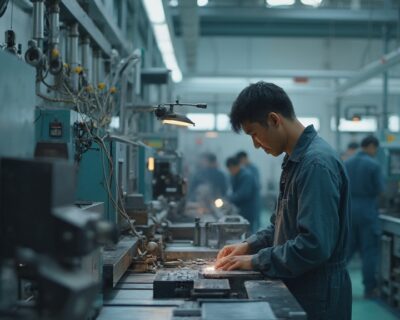Blogs

Innovative Materials Transforming Aerospace & Defense Technologies
Introduction
The aerospace industry stands on the brink of a transformative era, driven by the integration of innovative materials that promise to redefine the capabilities and sustainability of aviation and defense systems. Self-healing materials, nanomaterials, and advanced composites are leading the charge, offering unprecedented enhancements in durability, efficiency, and performance. These materials not only reduce maintenance costs and operational downtime but also pave the way for groundbreaking advancements in hypersonic flight and additive manufacturing.
As the sector moves towards achieving net-zero emissions and greater operational readiness, the collaboration between private innovations and government requirements becomes increasingly crucial. This article delves into the multifaceted impact of these cutting-edge materials, exploring their role in enhancing safety, sustainability, and overall efficiency in aerospace applications.
Self-Healing Materials for Aerospace Structures
Self-repairing substances are revolutionizing aerospace technology by greatly improving the durability and lifespan of aircraft components. These advanced substances autonomously repair damage caused by environmental stressors or mechanical wear, thereby drastically reducing maintenance costs and operational downtime. The integration of microcapsules filled with healing agents into the material matrix enables these composites to effectively seal cracks and restore structural integrity. This advancement not only enhances safety and dependability but also bolsters the operational preparedness of both civilian and military flight industries.
According to industry experts, the collaboration between private sector innovations and government requirements is critical in advancing these groundbreaking technologies, positioning the industry as a vital partner in national security. The advanced substances originally created for aviation are now drawing attention from several other sectors, playing a major role in sustainability. For instance, Robert Machtlinger, CEO of FACC, highlights the importance of such collaborations, stating, ‘By researching this approach together with our partners, we are making a significant contribution to more sustainability.’
Moreover, the trend towards sustainable practices in composite manufacturing is gaining momentum. Events such as CompositesWorld’s CW Tech Days are investigating technologies, resources, and strategies to assist composites producers in becoming more sustainable. ‘This shift towards sustainability is crucial as the demand for lightweight and durable substances continues to rise across various sectors, including aerospace.’.
Additionally, the development of a comprehensive digital component passport and a secure digital platform for information exchange is set to revolutionize remanufacturing processes. ‘This data-focused method will allow immediate monitoring of component quality, performance, and history, further guaranteeing the dependability and durability of aerospace substances.’.
Overall, the incorporation of self-repairing substances signifies a major advancement in aerospace technology, offering improved performance, lower expenses, and increased sustainability.

Nanomaterials and Atomic-Scale Development in Aerospace
Nanomaterials are transforming the aviation industry by offering exceptional mechanical properties and lightweight characteristics. These substances, designed at the atomic level, enable the creation of components that are not only lighter but also significantly stronger and more heat-resistant. This innovation is crucial for developing advanced thermal protection systems and sophisticated coatings that enhance the durability and performance of aircraft components in extreme environments.
The increased adoption of these nanomaterials is driven by the demand for more efficient, safer, and cost-effective aircraft. According to recent data, the use of nanomaterials in aerospace applications is expanding rapidly, with a notable impact on aerostructures, textiles, and glass components, thereby improving the overall comfort, safety, and affordability of aircraft.
Case studies from the industry highlight significant advancements. For instance, the integration of nanofibers into composite materials has shown great promise in reducing the risk of catastrophic failure, even under severe loading conditions. Such breakthroughs not only help in achieving the goal of lightweighting but also ensure the reliability and safety of aircraft structures.
Furthermore, industry events like CompositesWorld’s CW Tech Days underscore the growing interest in sustainable composite manufacturing processes. These events provide chances for specialists to explore groundbreaking materials, tools, and processing technologies that are essential for the future of aircraft manufacturing.
Overall, the ongoing research and application of nanotechnology are set to revolutionize the aviation industry, driving unprecedented growth and development. ‘The ability to manipulate materials at the nanoscale opens up new possibilities for innovation, making aerospace components more resilient and efficient.’.


Advanced Materials for Hypersonic Flight
‘Achieving hypersonic flight capabilities requires the development of advanced materials that can withstand extreme conditions.’. Ultra-high temperature ceramics (UHTCs) and specialized alloys are essential for building airframes and propulsion systems capable of speeds exceeding Mach 5. These materials must demonstrate exceptional thermal stability, strength, and resistance to oxidation, ensuring both safety and performance during high-speed flights.
Recent advancements in the field highlight the essential importance of these substances. Boeing’s advancements in sustainable materials and recycling highlight the aerospace industry’s dedication to both performance and environmental responsibility. As Krishnan Narayanan, Founding Partner at Clear Sky, points out, “Boeing is undoubtedly a leader in advancing the journey towards decarbonization in air travel,” reflecting the industry’s broader commitment to high-speed and eco-friendly flight.
Furthermore, the aviation industry’s goal of net-zero emissions by 2050 drives the integration of innovative technologies. Demonstration programs are vital for scaling up the most viable innovations, offering the necessary experience to assess their scalability and impact. The sector’s significant contribution to global climate protection efforts aligns with the development of robust materials for hypersonic flight, supporting the industry’s objectives of reducing its environmental footprint and ensuring long-term viability and resilience.
The quest for materials that can endure the extreme conditions of hypersonic flight continues to expand the limits of science regarding resources. Recent studies have shown that new porous high-entropy diboride ceramics can withstand temperatures up to 2,000 degrees Celsius, making them prime candidates for aerospace applications. These advancements are crucial as materials that can uphold their integrity under such conditions are key to the success of hypersonic systems.
In conclusion, the advancement of complex materials is not solely focused on attaining greater speeds but also on guaranteeing that these technologies are sustainable and environmentally responsible. The air travel sector’s dedication to creativity and eco-friendliness is leading to a new age of fast flight, with substance science at the forefront of this change.

Additive Manufacturing in Aerospace: Lightweight Components and Efficiency
Additive manufacturing, or 3D printing, is transforming the aerospace industry by enabling the creation of intricate, lightweight components that traditional methods cannot achieve. The technology significantly reduces resource waste and allows for rapid prototyping, facilitating quicker design iterations. Employing advanced substances like titanium alloys and high-performance polymers, producers can adhere to strict industry standards while enhancing efficiency. Recent advancements have made 3D printing less cost-prohibitive, with the release of affordable midrange machines. Moreover, the collaboration between academia and industry has spurred innovation, resulting in cutting-edge research and novel manufacturing techniques. This progressive approach is accelerating the acceptance and advancement of 3D printing technologies in various sectors, including air travel.
Composite Materials in Aerospace: High Strength-to-Weight Ratios and Thermal Stability
Carbon fiber reinforced polymers (CFRP) have become essential in modern aircraft engineering, thanks to their superior strength-to-weight ratios and thermal stability. These materials are essential in constructing key aircraft components such as wings and fuselages, enabling significant weight reduction without sacrificing safety or performance. CFRPs also show remarkable resistance to severe temperatures and corrosion, making them perfect for both commercial and military flight applications.
The widespread application of CFRPs in the aerospace industry is a testament to their efficiency and performance-enhancing characteristics. As emphasized by numerous professional awards, CFRP knowledge is not only essential in the aerospace sector but also fosters advancement in automotive, mechanical engineering, and even sports equipment markets. This cross-industry impact underscores the versatility and robustness of CFRPs.
Moreover, the design and optimization of CFRPs demand specialized knowledge and advanced simulation techniques. This complexity is reflected in the over 100 development projects realized in lightweight construction, involving customers from 14 countries. Such projects emphasize the necessity for a comprehensive understanding of resources and strong data to attain the best lightweight design.
The aerospace sector’s reliance on CFRPs is further highlighted by industry events such as CompositesWorld’s CW Tech Days and the CMS Conference. These platforms highlight state-of-the-art advancements in composite materials and their applications, underscoring the continuous innovation within the field.
In summary, the adoption of CFRP in aviation engineering is driven by its unparalleled strength, lightweight properties, and resilience under extreme conditions, positioning it as a cornerstone of modern aviation technology.


Impact of Innovative Materials on Aerospace & Defense Industries
‘The incorporation of cutting-edge components in aerospace and defense has resulted in significant improvements in performance, efficiency, and safety.’. Employing cutting-edge materials, including metamaterials and advanced composites, has significantly reduced overall weight, thereby enhancing fuel efficiency and operational range. This is particularly evident in the efforts by the Materials Project, which aims to reduce the time required to create new materials by focusing experiments on the most promising compounds identified through computational data sets. This initiative removes the guesswork from design, allowing researchers to target their efforts efficiently.
Furthermore, these advanced materials assist in the development of next-generation aircraft and defense systems that are more adaptable to emerging threats. For instance, the research group supported by a $2.25 million grant from the Air Force Office of Scientific Research is exploring the interactions between air and surface materials, a crucial requirement for the U.S. Department of Defense. This project not only aims to understand the fundamental physics but also to create and test these materials, thus accelerating the advancement of aerospace technologies.
‘The significance of these innovations is highlighted by the increasing need for lightweight, long-lasting materials across various sectors, including automotive and construction.’. Events like CompositesWorld’s CW Tech Days: Infrastructure highlight the latest trends and advancements in composite materials, emphasizing sustainability and efficiency.
As stated by Dr. Lorenzo Valdevit, a professor of science and engineering, interdisciplinary cooperation enhances the research experience and speeds up advancements. By merging knowledge from various disciplines, scientists can expand the limits of what is achievable in aviation and defense technologies. Such advancements are crucial for strengthening national security and improving operational capabilities, ensuring that defense systems remain robust and responsive to new challenges.


Future Trends and Applications of Innovative Materials in Aerospace & Defense
The aerospace and defense sectors are poised to gain significant advantages from the ongoing progress in advanced materials. Important trends include the use of bio-inspired materials, improved recycling techniques, and smart components capable of responding to environmental changes. These developments are not only set to enhance performance but also significantly contribute to sustainability initiatives, aligning with global endeavors to minimize environmental impact.
Bio-inspired materials are being developed to imitate natural processes, providing improved durability and efficiency. Enhanced recycling processes are increasingly being integrated into production cycles, reducing waste and promoting a circular economy. Intelligent materials, which can adapt to changes in their environment, are altering how structures respond to external factors, ensuring improved resilience and functionality.
The European Union’s Communication on Advanced Substances for Industrial Leadership emphasizes the significance of these elements in fostering innovation across different sectors, including energy, electronics, and mobility. Innovative materials are essential to the green and digital transitions, crucial for generating renewable energy, zero-emission structures, and sophisticated defense equipment.
Furthermore, the NSC’s emphasis on nanotechnology and advanced substances aims to bridge research gaps, ensuring the safe and sustainable development of these innovations. This approach supports societal acceptance and regulatory compliance, which are essential for widespread adoption.
As the demand for advanced materials grows, particularly for dual-use applications in defense and aerospace, the industry must stay abreast of these trends to remain competitive and sustainable in the long run.


Conclusion
The aerospace industry is experiencing a remarkable transformation, driven by the integration of advanced materials that enhance performance, safety, and sustainability. Self-healing materials are revolutionizing component durability, significantly reducing maintenance costs while improving operational readiness. The collaboration between private innovations and government mandates is vital for advancing these technologies, underscoring their importance in both civilian and military aviation.
Nanomaterials are further pushing the boundaries of aerospace capabilities by offering exceptional strength and lightweight properties. This atomic-scale innovation is crucial for developing components that perform reliably under extreme conditions, thus contributing to the overall safety and efficiency of aircraft. The ongoing research and application of these materials are critical for achieving the industry’s goals of enhanced performance and reduced environmental impact.
In the pursuit of hypersonic flight, the development of ultra-high temperature ceramics and specialized alloys is essential for ensuring safety and performance at extreme speeds. These advancements align with the industry’s commitment to sustainability and net-zero emissions, showcasing a dedication to responsible innovation.
Additive manufacturing is also reshaping the aerospace landscape by facilitating the production of intricate, lightweight components while minimizing resource waste. This technology, combined with advanced composite materials like carbon fiber reinforced polymers, is essential for meeting the stringent demands of modern aerospace engineering.
As the aerospace and defense sectors continue to evolve, the emphasis on innovative materials will play a pivotal role in addressing emerging challenges. The focus on bio-inspired substances, enhanced recycling methods, and intelligent components reflects a commitment to sustainability and operational excellence. Staying at the forefront of these advancements is crucial for maintaining competitiveness and ensuring the long-term viability of aerospace technologies.




